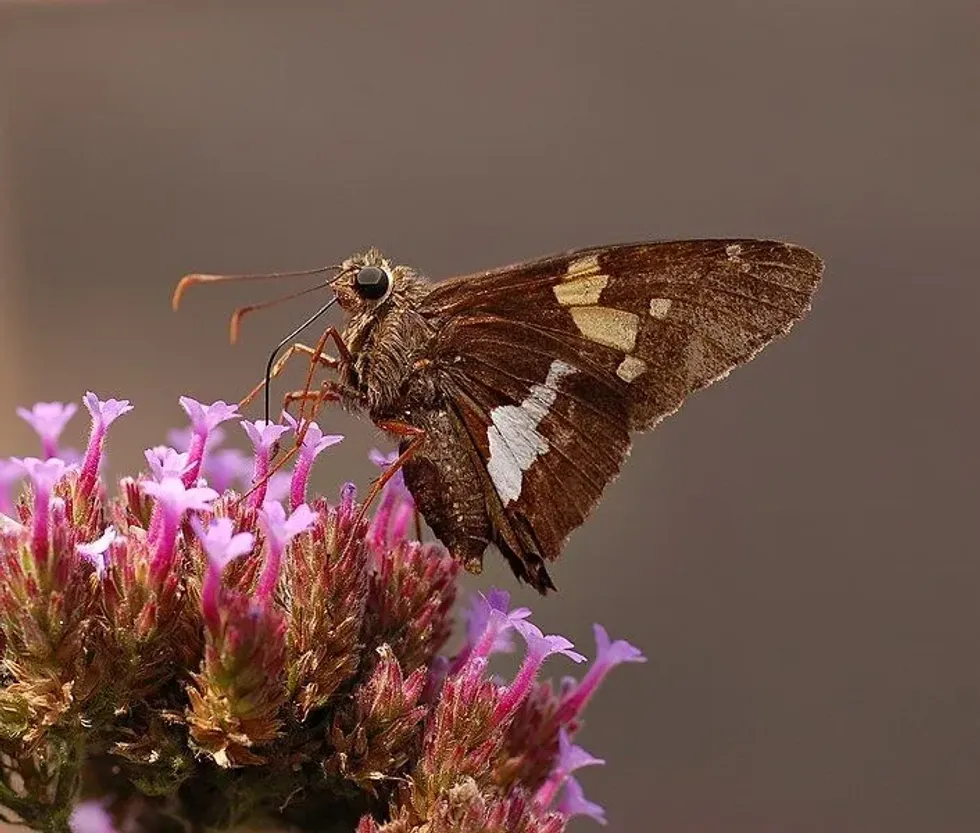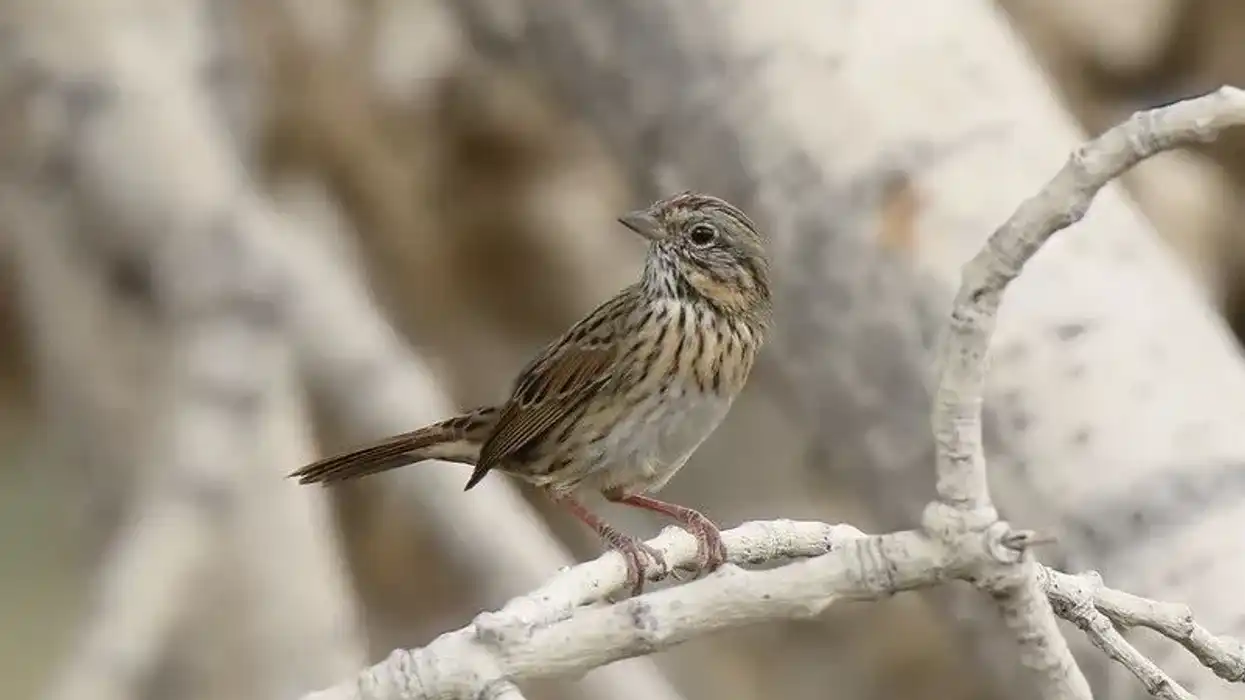The silver spotted skipper (Epargyreus clarus) is one of the most commonly found butterflies. This species of butterflies and moth look like each other, but they are butterflies and not a moth.
The silver spotted skipper (Epargyreus clarus) is found across the southern Canadian border and along a major portion of the North American continent including northern Mexico. This butterfly usually prefers open fields and regions and is commonly found at forest edges.
They are also found along brushy areas, swamps, and riparian habitats at lower elevations.
Epargyreus clarus have an average wingspan of around 1.75-2.62 in (4.4-6.7 cm) and have a moth-like hairy body. Looking at a wing of a silver spotted skipper (Epargyreus clarus), you’ll find that it is dark brown like the rest of its body and has yellow-orange medial patches.
The male has a slight distinction than its female counterpart as the wing is more pointy in a male. The silver spotted skipper (Epargyreus clarus) is known to consume leaves and legumes as food from a number of herbs, shrubs, vines, and trees in the pea family.
Adults of this species are diurnal in nature and fly from early to midsummer. The Epargyreus clarus is also known as a nectar-thief species.
You'll find in this article information about silver spotted skipper feeding habits, silver spotted skipper caterpillar and adult stage, silver spotted skipper caterpillar plant diet, silver spotted skipper larvae stage, silver spotted skipper status in North America, and caterpillars, butterflies, and moths feeding habits.
For more relatable content, check out these white admiral butterfly facts and queen butterfly facts for kids.
Silver Spotted Skipper Interesting Facts
What type of animal is a silver spotted skipper?
Although it looks a lot like moths, the silver spotted skipper (Epargyreus clarus) is a butterfly of the Hesperiidae family. It is quite a familiar and well-known butterfly in the North American region.
The silver spotted skipper (Epargyreus clarus) is a perching species. They eat shrubs and legumes of various plants like false indigo bush. Some other butterflies are red admiral butterfly and painted lady butterfly.
What class of animal does a silver spotted skipper belong to?
The silver spotted skipper (Epargyreus clarus) belongs to the Animalia kingdom and Insecta class.
How many silver spotted skipper are there in the world?
As per estimates, its population has remained safe and has continued to grow slowly since 1980 after a sharp drop in the mid 1900s. Although they feed on crop plants like soybeans and kidney beans, they are not known to devastate a field of these crops.
Where does a silver spotted skipper live?
The silver spotted skipper (Epargyreus clarus) enjoys various temperate environments. They are found in abundance in the North American and southern Canadian region.
These butterflies are known to migrate as a brood and are diurnal in nature. They fly from early to midsummer. In terms of numbers, they have one brood per year going from north to west, two in the east and as high as three to four broods in the southern region.
What is a silver spotted skipper's habitat?
As a temperate species, the silver spotted skipper (Epargyreus clarus) is found in abundance in bushy areas, open fields, forest edges, and riparian habitats. All these places are supposed to be at lower elevations.
They are often seen flying over a wide variety of flowers like black locust (Robinia pseudoacacia), honey locust (Gleditsia triacanthos), kudzu (Pueraria montana), dixie ticktrefoil (Desmodium tortuosum), Chinese wisteria (Wisteria sinensis), and mud.
The larvae of a silver spotted skipper (Epargyreus clarus) make and live in leaf shelters of the host plant.
The young larvae make this leaf shelter by stitching several leaves together using silk. During certain nights, hot or cloudy days, they are known to hang under a leaf of host plants for shelter.
Who do silver spotted skipper live with?
The silver spotted skipper (Epargyreus clarus) enjoys time with its own kind. While the brood travels together, the males still try to maintain their own space.
They try to maintain their own territory, usually a leaf, and wait for females or other insects from the leaves of their host plant. In contrast, females of this species are known to travel over long distances to find mates.
How long does a silver spotted skipper live?
A silver spotted skipper (Epargyreus clarus) is known to live for one and a half to two months. This includes the larval and adult stage.
How do they reproduce?
The females of this species do not receive ejaculation like many other species. Instead, they fly around and look for spermatophores on a host plant from a male for each copulation.
Once received, the females will then avoid males and then look for a safe space to lay their eggs on host plants like black locust (Robinia pseudoacacia). The larva, with a green body and dark reddish brown head, builds a leaf shelter to protect itself and wait for the date when it will hatch.
What is their conservation status?
The silver spotted skipper (Epargyreus clarus) has been given the conservation status of Least Concern.
Silver Spotted Skipper Fun Facts
What do silver spotted skipper look like?
The silver spotted skipper (Epargyreus clarus) has a wingspan of around 1.75-2.62 in (4.4-6.7 cm). They are one of the most commonly identified butterflies in the region.
They have a brown colored body and a yellow-orange patch on the median of its wings. A wing of the males is relatively more pointy than a female's wing. These brown butterflies collect nectar from purple, blue, red, pink and occasionally white and cream-colored flowers.
They are known to avoid yellow colored flowers completely. It seems like they do not like yellow flowers at all.
How cute are they?
The brown and orange colors on a silver spotted skipper (Epargyreus clarus) are rather dull compared to other butterflies.
How do they communicate?
Silver spotted skippers are known to have compound eyes and they use these to sense and perceive ultraviolet light like other butterflies. Their antennas act like sensory organs and allow them to smell odors, touch, and possibly hear sound. They are also known to use pheromones to communicate.
How big is a silver spotted skipper?
The wingspan of a silver spotted skipper (Epargyreus clarus) is not very big. The wingspan is around 1.7g-2.62 in (4.4-6.7 cm) for adults. This is almost half as big as the screens of our modern smartphones.
How fast can a silver spotted skipper fly?
Silver spotted skippers are known to be quite fast at flight. They move their brown and orange wings very fast and often produce an audible buzz when flying.
How much does a silver spotted skipper weigh?
We do not know how much a silver spotted skipper butterfly weights.
What are the male and female names of the species?
The only notable difference is that the wing of adult males is more pointy than adult females. Because of this, silver spotted skipper adults are not given different names.
What would you call a baby silver spotted skipper?
Babies are called larvae. The eggs are laid on a host plant and the larvae build a leaf shelter to protect themselves from predators.
What do they eat?
The silver spotted skipper eat leaves, legumes and nectar of various plants, shrubs, and trees. They collect nectar from a wide variety of flowers of blue, red, pink, and purple colors. They occasionally delve in white flowers as well but never collect nectar from yellow flowers.
Are they poisonous?
The silver spotted skipper butterfly is not poisonous.
Would they make a good pet?
The silver spotted skipper is a butterfly with a small lifespan which thrives in the wild because of the availability of various resources it needs to survive. Keeping it as a pet would not be a wise decision.
Did you know...
These butterflies are extremely sensitive to Baculovirus infection. This infection makes them leave their leaf shelters and is used as a pesticide against this species.
The Hawkmoth caterpillar is the largest in the UK.
How do silver spotted skippers defend against predators?
The larvae of silver spotted skippers are extremely vulnerable to various predators like Crematogaster ants and paper wasp foragers. These predators tirelessly hunt the dark reddish brown head of the silver spotted skipper caterpillar.
To protect themselves from these predators, the larvae build a nest by stitching various leaves of the host plant together with their silk, making a leaf shelter. When disturbed, they regurgitate an unpleasant greenish chemical to protect themselves.
Why do silver spotted skippers launch their frass?
The predators of the silver spotted skipper larvae identify its leaf shelters and follow them by identifying the odor coming from their frass. Frass is a less solid excreta of some insects.
To confuse and send the predators away, the larvae launch their frass. The larvae do this by using an anal comb and fling the frass as far as 38 body lengths away from them.
Here at Kidadl, we have carefully created lots of interesting family-friendly animal facts for everyone to discover! Learn more about some other arthropods from our fishfly facts and gumboot chiton facts pages.
You can even occupy yourself at home by coloring in one of our Silver Spotted Skipper coloring pages.









